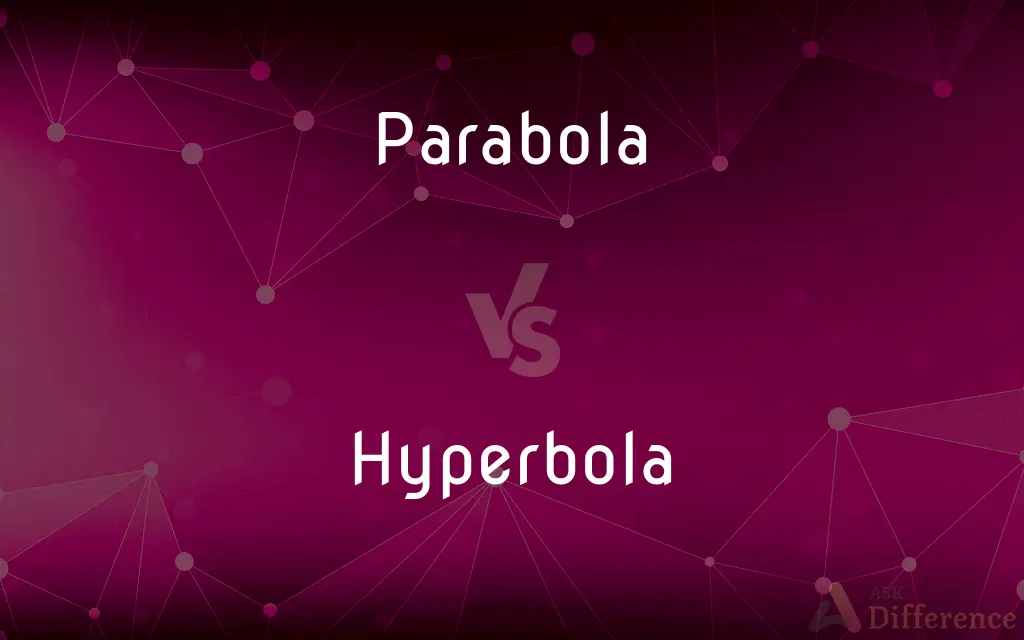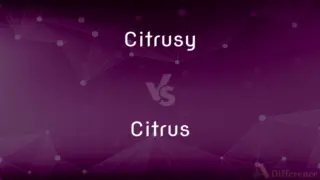Parabola vs. Hyperbola — What's the Difference?
By Tayyaba Rehman — Updated on November 2, 2023
A parabola is a U-shaped symmetrical curve, while a hyperbola consists of two separate, mirror-image curves.

Difference Between Parabola and Hyperbola
Table of Contents
ADVERTISEMENT
Key Differences
A parabola is a curve where any point is at an equal distance from a fixed point (the focus) and a fixed straight line (the directrix). This U-shaped graph represents the path of an object in projectile motion under uniform gravity, with no other forces acting (like air resistance). It is one of the conic sections that can be formed by intersecting a plane with a cone at a certain angle. Hyperbolas, by contrast, are formed when the plane intersects the cone at a sharper angle, resulting in two separate, mirror-image curves that open away from each other.
Parabolas have a single axis of symmetry and one vertex, the point where the curve changes direction. The arms of a parabola extend indefinitely and never close. Hyperbolas also have two axes of symmetry and two vertices, one for each branch of the curve. Unlike parabolas, the arms of the hyperbola branches do not extend in a single direction but open out in two opposing directions, resembling an "X" shape if the asymptotes are drawn.
The equations for parabolas and hyperbolas reflect their different structures.
In practical applications, parabolas are seen in the design of satellite dishes and car headlights, where they are used to focus signals and light. Hyperbolas find their place in navigation systems, such as GPS and LORAN, due to their property of having a constant difference of distances from the foci to any point on the curve, which helps in determining locations.
Both parabolas and hyperbolas represent mathematical concepts that have significant implications in physics, engineering, and other scientific disciplines. While both are conic sections, their distinct shapes and properties lead to different uses and characteristics in various applications.
ADVERTISEMENT
Comparison Chart
Shape
U-shaped curve
Two separate, mirrored curves
Number of Branches
One
Two
Symmetry
One axis of symmetry
Two axes of symmetry
Asymptotes
No asymptotes
Two asymptotes
Compare with Definitions
Parabola
A shape created by slicing a cone with a plane parallel to one of its sides.
In mathematics class, we learned how to graph a parabola.
Hyperbola
Any point on a hyperbola has a constant difference of distances from two fixed points.
The navigation system uses the distance property of a hyperbola for location tracking.
Parabola
A U-shaped curve with each point equidistant from a fixed point and line.
The path of the basketball described a perfect parabola.
Hyperbola
Has two axes of symmetry, which intersect at the center of the hyperbola.
The hyperbola has a vertical and a horizontal axis of symmetry.
Parabola
A set of points with equal distance to a directrix and focus.
She illustrated the focus-directrix property of a parabola in her presentation.
Hyperbola
The branches of a hyperbola approach two lines, but never intersect them.
Graphing a hyperbola requires understanding its asymptotic lines.
Parabola
A parabola has the property that it can focus parallel rays to its focus.
The reflective property of a parabola is used in telescope designs.
Hyperbola
Consists of two unconnected branches that are mirror images.
The orbits of some comets around the sun are hyperbolic.
Parabola
In mathematics, a parabola is a plane curve which is mirror-symmetrical and is approximately U-shaped. It fits several superficially different mathematical descriptions, which can all be proved to define exactly the same curves.
Hyperbola
A shape formed by intersecting a cone with a plane at an angle greater than the cone's side.
A hyperbola is characterized by its two asymptotes.
Parabola
A symmetrical open plane curve formed by the intersection of a cone with a plane parallel to its side. The path of a projectile under the influence of gravity follows a curve of this shape.
Hyperbola
In mathematics, a hyperbola (listen) (adjective form hyperbolic, listen) (plural hyperbolas, or hyperbolae (listen)) is a type of smooth curve lying in a plane, defined by its geometric properties or by equations for which it is the solution set. A hyperbola has two pieces, called connected components or branches, that are mirror images of each other and resemble two infinite bows.
Parabola
A plane curve formed by the intersection of a right circular cone and a plane parallel to an element of the cone or by the locus of points equidistant from a fixed line and a fixed point not on the line.
Hyperbola
A symmetrical open curve formed by the intersection of a circular cone with a plane at a smaller angle with its axis than the side of the cone.
Parabola
(geometry) The conic section formed by the intersection of a cone with a plane parallel to a tangent plane to the cone; the locus of points equidistant from a fixed point (the focus) and line (the directrix). Category:en:Functions Category:en:Curves
Hyperbola
A plane curve having two branches, formed by the intersection of a plane with both halves of a right circular cone at an angle parallel to the axis of the cone. It is the locus of points for which the difference of the distances from two given points is a constant.
Parabola
(rhetoric) The explicit drawing of a parallel between two essentially dissimilar things, especially with a moral or didactic purpose. A parable.
Hyperbola
(geometry) A conic section formed by the intersection of a cone with a plane that intersects the base of the cone and is not tangent to the cone. The function y(x) = 1/x draws a hyperbola.
Parabola
A kind of curve; one of the conic sections formed by the intersection of the surface of a cone with a plane parallel to one of its sides. It is a curve, any point of which is equally distant from a fixed point, called the focus, and a fixed straight line, called the directrix. See Focus.
Hyperbola
A curve formed by a section of a cone, when the cutting plane makes a greater angle with the base than the side of the cone makes. It is a plane curve such that the difference of the distances from any point of it to two fixed points, called foci, is equal to a given distance. See Focus. If the cutting plane be produced so as to cut the opposite cone, another curve will be formed, which is also an hyperbola. Both curves are regarded as branches of the same hyperbola. See Illust. of Conic section, and Focus.
Parabola
A plane curve formed by the intersection of a right circular cone and a plane parallel to an element of the curve
Hyperbola
An open curve formed by a plane that cuts the base of a right circular cone
Parabola
The graph of a quadratic function is a parabola.
The parabola on the graph opens upwards because the coefficient is positive.
Common Curiosities
What defines a parabola?
A parabola is defined by its characteristic U-shaped curve, representing all points equidistant from a focus and directrix.
What is a hyperbola?
A hyperbola is a set of all points where the difference in distances to two foci is constant, resulting in two diverging curves.
How are parabolas and hyperbolas related?
Both parabolas and hyperbolas are conic sections, geometric shapes obtained by intersecting a plane with a cone.
Can parabolas and hyperbolas have horizontal orientations?
Yes, both can be oriented horizontally or vertically depending on the coefficients in their equations.
What is the vertex of a parabola?
The vertex of a parabola is the peak or the lowest point of the curve, depending on its orientation.
Where do we see parabolas in real life?
Parabolas are seen in the design of reflectors, antennas, and in the trajectory of projectiles.
Can the arms of a hyperbola intersect?
No, the arms of a hyperbola will never intersect as they extend in opposite directions.
What is the directrix of a parabola?
The directrix of a parabola is a fixed line used in the definition of the curve.
Is the focus of a parabola inside the curve?
Yes, the focus of a parabola lies inside the curve, along its axis of symmetry.
Are hyperbolas ever seen outside of mathematics?
Hyperbolas appear in navigation systems, art, and architecture due to their unique properties.
Does a hyperbola have a vertex?
A hyperbola has two vertices, one for each branch of the curve.
What are the foci of a hyperbola?
The foci of a hyperbola are two fixed points used in the curve's formal definition.
Do parabolas have asymptotes?
No, parabolas do not have asymptotes; their arms extend indefinitely without approaching a straight line.
Are parabolas and hyperbolas symmetrical?
Yes, both are symmetrical, but a parabola has one line of symmetry, while a hyperbola has two.
What are the asymptotes of a hyperbola?
The asymptotes of a hyperbola are straight lines that the curve approaches but never intersects.
Share Your Discovery

Previous Comparison
Citrusy vs. Citrus
Next Comparison
Britches vs. PantsAuthor Spotlight
Written by
Tayyaba RehmanTayyaba Rehman is a distinguished writer, currently serving as a primary contributor to askdifference.com. As a researcher in semantics and etymology, Tayyaba's passion for the complexity of languages and their distinctions has found a perfect home on the platform. Tayyaba delves into the intricacies of language, distinguishing between commonly confused words and phrases, thereby providing clarity for readers worldwide.














































